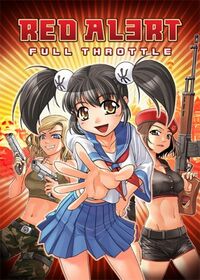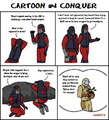Command and Conquer


|
This is a /v/ related article, which we tolerate because it's relevant and/or popular on /tg/... or we just can't be bothered to delete it. |
"He who controls the past commands the future, He who commands the future, conquers the past."
- – Kane
Long ago, back before vanilla Dawn of War, back when Starcraft wasn't even a sketch in the minds of Blizzard, one franchise ruled above all others in the RTS genre, Westwood's Command and Conquer.
While some scholars argue Dune 2 was the first prototype of the real-time strategy genre, most fans and critics recognize Command and Conquer as the game that made the genre popular among the public.
Main series/Tiberian Universe

Follows the conflicts between the Global Defense Initiative, a military coalition formed by the United Nations, and the Brotherhood of Nod, a mysterious quasi-religious global power led by the being only known as Kane spanning nearly a century of warfare. A key element of the series is Tiberium, an alien substance which is slowly xenoforming the Earth, destroying the ecosystem but also giving mankind unique industrial and scientific possibilities.
The games of the series:
- Tiberian Dawn: where it all started, Earth is still widely similar to our own, this game features what may become the standard for the industry.
- The Covert Operations: more missions! And hard as fuck.
- Sole Survivor: Just don't, I mean, seriously?! You control only one unit?! If i wanted to play a MOBA I would, well I would dig my eyes out with a melon baller but you get the point!
- Renegade: a FPS/TPS featuring Nick "Havoc" Parker, a trigger happy GDI commando.
- Tiberian Sun: Grimdark cyberpunk heavy setting, with the entire world altered by by Tiberium into a hellscape, mutants, cyborgs and futuristic weapons such as mechs, lasers and hover technology, it has arguably some of the best cutscenes and scenarios of the game, Uniquely, for Command and Conquer over all, it has the commanders of GDI and Nod as characters, not the player in front of his computer screen.
- Firestorm: CABAL, the supercomputer of the Brotherhood of Nod, goes rogue, attempting to turn everyone into cyborgs to accomplish Kane's master plan. Included new scenarios, more options and units.
- Tiberium Wars: Combining the the cyberpunk style with 20-minutes-in-the future of your Dale Brown novels, it introduces the Scrin, the alien empire that seeded the world with Tiberium for its mining operations.
- Kane's Wrath: This expansion centers on everyone's favourite dark messiah, and also adds new units and abilities to all factions. In terms of narrative and plot twists it's one of the most elaborate episodes of the tiberian saga.
- Tiberian Twilight: Awful plot inconsistencies and over-exhaustion of the brand combined with significant gameplay changes made this a huge disappointment, it was later revealed that what the fans bought was originally going to be a free-to-play MMO real tactical game for the weaboo market. Believed by the fandom to have killed the series.
- Tiberium Alliances: It's a browser RTS. That should tell you all you need to know.
- Rivals: A mobile game where two groups fight for command of a central point; conquering it lets you level your opponent's base in one blow. Uses a CGI Kane instead of rehiring Joseph D. Kucan, which is both a blessing and another mockery of the franchise. If Tiberium Twilight killed C&C, then Rivals is tantamount to necrophilia.
Red Alert series

Originally considered a prequel but ultimately earning its own continuity it starts with Albert Einsten creating a time machine to go back to the 1920s and erase Hitler from history, this ends not as planned. Red Alert follows the battle between the Soviet Union and the Allies during a series of World Wars where every faction seems to deploy increasingly batshit insane wacky technology. The franchise consists on three games and its expansions, the two later add a new faction, first Yuri, a rogue Soviet psyker who attempts to mind-control the entire planet and has a badass army of flying saucers, hulk-like soldiers, virus snipers, grinders that recycle mind-controlled people into natural resources, and some other nasty grimdark stuff, and the second features the Empire of the Rising Sun, a God-Emperor-worshipping Technology Cult which adds transforming mechas, a psionics schoolgirl and beam-katanas, yes, Red Alert is that weird what you may expect from an elegan/tg/entlenman production.
The games of the series
- Red Alert: After messing up with time, Einstein leaves the stage open for Iosif Stalin to try to conquer Europe, , the rest is history. Gameplay-wise is the same as Tiberium Dawn, with a very grimdark outlook upon the course of the war.
- Counter-Strike: more missions!(yeah, back in that time that was the best thing you could expect from an expansion).
- Aftermath: More missions and more units.
- Red Alert 2: The Soviets come back and invade the United States, and did we mention the Russians are backed up by the Cubans, the Libyans and the Iraqis? Prism technology, desolator troops to irradiate whole areas with nuclear power, tesla tanks, chronospheres, weather control devices and iron curtain shields are used in this war as standard weaponry. On a side note, this is where Red Alert started to be stop being "Serious" and start getting campy.
- Yuri's Revenge: creepy former adviser of Soviet premier Romanov (yes, we know that was the Tsar surname), Yuri has been using the Soviet invasion onslaught as a distraction to build a network of psychic dominator devices to mind-control the whole planet. unfortunately for him and thankfully for everyone else the Allies travel back in time in order to topple him (and you though Orikan the Diviner was cheating hard), ensuring during the process a temporal alliance between the Soviets and the Allies to crush him. More time travel silliness ensues.
- Red Alert 3: The Soviets decide to attempted to pull the time travel trick by themselves and they actually succeeded at killing Einstein. Somehow this turned Japan into the Empire of the Rising Sun, complete with nanolathing technology, laser beams, extreme miniaturization and artistic weaponry from the future. By this point, and with the inclusion of Japan, you know this has gone completely bonkers.
- Uprising: Singleplayer only. More units, a campaing involving a psionic schoolgirl, and a a complete disregard for balance in the form of units such as the Empire's Gigafortress and the Allied Harbinger Gunship. The main campaigns were pretty boring though, being way too short, with a bare bones story with very little of the humor that had characterized the series.
Generals series

The more realistic branch of the series. The Islamic State Global Liberation Army ravages the Mideast in order to achieve their shadowy agenda, while the United States of America and China join forces to show the evil terrorists they can't mess around with the new world order. In retrospect it had the misfortune to be released right as the above plot was growing too similar to real world events, which meant it wasn't nearly as popular as its cousins.
The games of the series:
- Generals: You got your three factions, modern USA, communist China, and mideast
Islamic StateGlobal Liberation Army, great variety of tactics, fun missions, sadly it lacked the awesome cutscenes of the Tiberian and Red Alert series and barely explains where the GLA came from. From a gameplay perspective this one stands out the most apart from the rest of Command and Conquer. Resources are gathered from fixed points on the map, all factions have ways to get infinite money meaning turtling and just nuking, skud-storming or lasering your enemy is more viable (one sub-faction in the expansion even specializes in it).- Zero Hour: New subfactions! More units, and missions! Also cutscenes! It also brought a challenge mode where you fights against the generals of each faction (ergo the name of the game mode).
- Generals 2: Was looking awesome and ready to reignite the franchise, but got cancelled.
Tiberian Gallery
-
Democracy is not negotiable!
-
GDI lego fans make it happen!
-
Old school photoshop.
-
You don't get more cyberpunk that Tiberian Sun's Brotherhood of Nod.
-
Reddish and cybernetic, the way the Adeptus Mechanicus like it!
-
Beware Tiberium's mutating power!
-
Tyranids wish their monstrous creatures were half as good as a Scrin Eradicator Hexapod.
-
Skillful fans have been capable to make minis of some of the units.
-
Sadly it seems like EA followed the taurox and centurion designing vibe with C&C4.
Red Alert Gallery
-
Hitler making a cameo.
-
We got comrade Stalin!
-
And professor Einstein!
-
Dem fanservice!
-
THE LEVELS OF WEABOO ARE OVER 9000!
-
More anime...
-
Soviet fans trying to achieve enuff dakka.
-
2000100,000 volts coming up! -
The Empire of the Rising laughs at silly things such as logic weapon design.
Generals Gallery
-
Capcom style.
-
We love our boxes.
-
It's hard to be GLA in these days...
-
Problem titanicus?
See also
- C&C Wiki, for those of you who want to explore more.
- CnCNZ, longtime fansite with news, updates and goodies.
- Frank Klepacki, composer of many of the C&C tracks.
- [1] The Paradox wiki.




















